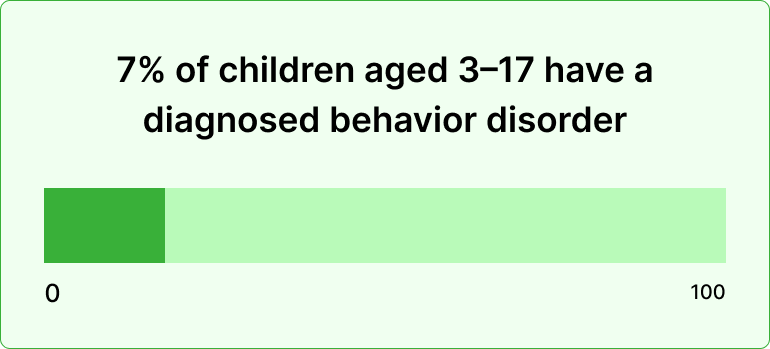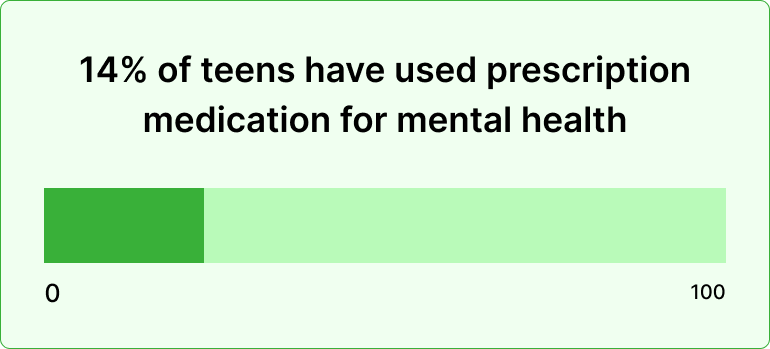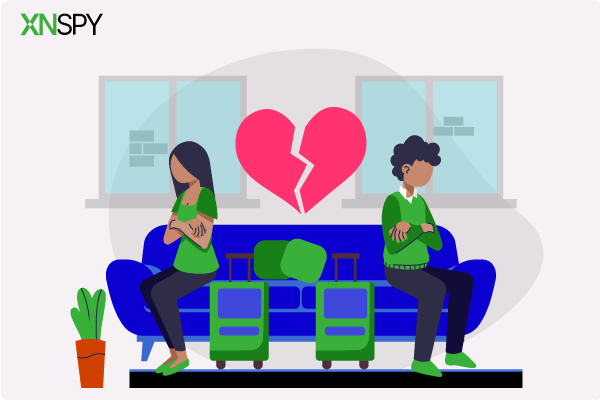The complete monitoring experience for your phone
Get XNSPY and start tracking calls, texts, multimedia, locations and more on any phone!
Get Started Now Live DemoMental health issues have existed since the dawn of time. However, the long-standing taboo surrounding them and the stigmatization of those who suffer have led many to dismiss their seriousness.
As a result, mental health has often been pushed aside and treated as something unimportant. In a world so hesitant to acknowledge the issue, the idea that teenagers, too, can suffer from mental health disorders has taken a backseat.
What have been the consequences of such neglect? A steady rise in the percentage of teens with depression and other mental health disorders! So much so that today, teenagers are bearing the brunt of a problem we have ignored for far too long.
Now is a high time for us, as parents and adults, to educate ourselves not only about the mental health challenges teens face but also about the ways to prevent these issues.
Overview of How Many Teens Struggle with Mental Health

1. About 14% of adolescents worldwide face a mental health disorder at some point.
2. Close to 10% of young people between 5 and 16 years old meet the criteria for a clinically diagnosable mental health condition.
3. Mental health conditions account for 15% of the total disease burden in young people aged 10-19 worldwide.
4. Roughly one in five adolescents may deal with a mental health issue in a single year.
5. Around 1 in 2 individuals who experience mental health issues later in life start showing symptoms by age 14.
6. Half of all mental health disorders first appear by age 14, and three‑quarters have emerged by age 24.
7. Roughly 42% of high schoolers report regularly feeling down or hopeless.
8. An estimated 22% of teens have seriously thought about ending their own lives.
9. Only half of the youth aged 6 to 17 who live with a mental health issue receive treatment each year.
10. 55% of adults acknowledge that there is a serious mental health issue among today’s youth.
Here’s What You Might Like to Read Next
📈 79+ Screen Time Statistics for Kids and Teens + Tips to Reduce It
🏅 75+ Cyberbullying Statistics Every Concerned Parent Should Know
📖 Dangerous TikTok Challenges Every Parent Should Be Aware Of
🛑 27+ Most Dangerous Apps for Kids: Names, Dangers, and Alternatives
Teen Mental Health Statistics Based on Different Categories
11. Almost one‑fifth (20%) of American children and adolescents aged 3-17 have at least one diagnosed mental, emotional, developmental, or behavioral disorder.
12. Among Australians aged 16-24, nearly 40% experienced a diagnosable mental health condition in the past year.
13. Suicide rates among Native American teens are nearly 3.5 times higher than the national average.
14. 14% of LGBTQ youth report a suicide attempt, with the number rising to 20% among transgender and nonbinary youth.

15. Nearly 60% of teenage girls said they felt persistent sadness for at least two weeks.
16. Approximately 89 million boys and 77 million girls live with a diagnosable mental disorder.
17. 9.8% of Black adolescents reported attempting suicide in the past year, compared to 6.1% of White adolescents and 8.2% of Hispanic adolescents.
18. 40% of Latino high schoolers reported feeling sad or hopeless for more than two weeks.
19. Rural adolescents aged 15-19 have a suicide rate of 15.8 per 100,000, which is 54% higher than their urban counterparts.
20. Adolescents from low socioeconomic backgrounds have a 9.7% prevalence of anxiety disorders and an 8.4% prevalence of conduct disorders.
Teen Mental Health & Emotional Disorders
21. Disorders classified as anxiety or depression together represent roughly 40% of all mental health diagnoses in 10 to 19-year-olds.
Teen Depression Statistics
22. Teenage depression statistics indicate that roughly 4% of children aged 3-17 have a diagnosed depressive disorder.
23. Approximately 13% of adolescents aged 12-17 carry a formal diagnosis of depression.
24. The proportion of 16-17‑year‑olds diagnosed with major depressive disorder has climbed by nearly 69% by the late 20s.
25. Approximately 20% of teens experience a depressive episode by the time they’re 17.
26. Around 15.1% of adolescents report at least one episode of major depression.
27. 17% of teens report feeling depressive symptoms over fourteen days.
28. Depressive conditions affect around 1.4% of youngsters between 10 and 14, and increase to about 3.5% in the 15-19 age group.
29. Major depressive disorder affected 5% of 12-17‑year‑olds, compared to 1.1% of those aged 4-11.
30. Teen girls are twice as likely as boys to develop clinical depression.
31. 75% of teens dealing with depression are also diagnosed with another mental disorder.
What Percentage of Teens Have Anxiety

32. About 31.9% of adolescents are estimated to be living with some form of anxiety disorder.
33. One in ten children (ages 3-17) has a formal anxiety diagnosis.
34. Over a period of 8 years, reports of anxiety or persistent hopelessness among 17-25‑year‑olds have increased by about 71%.
35. Roughly 4.4% of children aged 10-14 live with an anxiety disorder, rising to about 5.5% among those aged 15-19.
36. 8.3% of teens report symptoms severe enough to significantly disrupt daily life.
37. 21% of teens say they have experienced anxiety symptoms within the past two weeks.
38. About 32% of young people between 13 and 18 meet clinical criteria for an anxiety disorder.
39. Girls show higher rates of anxiety (38%) compared to boys (26.1%).
40. Teens aged 17 to 18 have the highest reported cases of anxiety disorders.
Suicidal Teens and Mental Health Issues
41. Nearly 9% of teens have attempted suicide at least once.
42. Self-harm is the second leading cause of death for 10-14‑year‑olds.
43. Suicide is now the fourth most common cause of death among teens aged 15 to 19.

45. 45% of LGBTQ-identifying youth say they have seriously contemplated suicide.
46. About 15.7% of adolescents say they’ve made a suicide plan.
47. In the U.S., self‑inflicted injury now ranks as the second leading cause of death for adolescents aged 15-19.
48. The suicide mortality rate in teens aged 15-19 is around 10.6 per 100,000 teens.
49. There are 389 self‑harm-related hospital stays per 100,000 young people aged 15-19.
50. Suicide accounted for 30.9% of all fatalities in 15-17 year olds and 32.4% in 18-24 year olds.

Worried About What Your Teen Isn’t Saying?
Use XNSPY to monitor their digital behavior and detect early warning signs.
Mental Health for Teens With PTSD
51. Among adolescents exposed to trauma, 15.9% develop PTSD.
52. Around 25% of adolescents go through at least one traumatic experience by age 16.
53. About 19% of teens report three or more different traumatic experiences.
54. The prevalence of PTSD among adolescents increases with age: 3.7% for ages 13-14, 5.1% for ages 15-16, and 7.0% for ages 17-18.
55. Among trauma survivors, 15% of girls and 6% of boys develop post-traumatic stress disorder.
Schizophrenia Statistics in Teens
56. Schizophrenia is diagnosed in around 0.1% of adolescents aged 15-19.
57. Each year, an estimated 100,000 young people (ages 15-25) experience their first psychotic episode.
58. Among adolescents diagnosed with psychiatric conditions between the ages of 14 and 17, 9% develop schizophrenia spectrum disorders over eight years.
59. Very early-onset schizophrenia, occurring before the age of 13, is exceedingly rare, with an estimated prevalence of approximately 2 per 100,000 children.
60. 63.5% of adolescents diagnosed with schizophrenia between the ages of 10-17 were male.
Teenage Mental Health Statistics for Behavioural Disorders

61. Approximately 7% of children aged 3-17 are living with a diagnosed behavior disorder.
OCD Teens Mental Health
62. 2.0% of adolescents aged 12-17 in the United States reported experiencing OCD symptoms in the past year.
63. In roughly 25% of OCD cases, symptoms begin by age 14.
64. 15% of teens with OCD report suicidal ideation.
65. Among adolescents with OCD, 55.9% also had attention-deficit/hyperactivity disorder (ADHD).
ED Youth Mental Health Statistics
66. Approximately 13% of adolescents develop an eating disorder by the age of 20.
67. Eating disorders show up in roughly 0.1% of 10-14‑year‑olds.
68. 54% of LGBTQ+ American adolescents had been formally diagnosed with an eating disorder.
69. Among adolescents, 35-57% of girls engage in crash dieting, fasting, self-induced vomiting, diet pills, or laxatives.
ODD and CD in Teens
70. 3% of adolescents aged 12-18 are diagnosed with Oppositional Defiant Disorder (ODD).
71. Conduct Disorder (CD) appears in close to 3.5% of 10-14‑year‑olds.
ADHD Mental Health Issues in Teens
72. 15.5% of U.S. adolescents aged 12-17 were diagnosed with ADHD
73. ADHD is present in approximately 2.9% of early adolescents.
74. ADHD accounts for approximately 19.5% of all mental health diagnoses in this age group.
75. ADHD diagnoses among U.S. adolescents aged 12-17 have increased by 4.8 percentage points over the past two decades.
Mental Health in Teens With Different Types of Addiction
76. Teens addicted to alcohol are 1.7 times more likely to experience anxiety and depression symptoms.
77. Adolescents who abuse drugs are 40% more likely to develop mood disorders.

78. 37% of adolescents with substance use disorders also experience major depressive episodes.
79. Teenagers addicted to cannabis have a 60% higher likelihood of experiencing psychotic symptoms, including paranoia and hallucinations.
80. Global cannabis use among adolescents has reached 5.5%, compared to 4.4% in adults.
81. Teens addicted to social media are 2.1 times more likely to develop anxiety disorders compared to those with moderate or low usage.
82. Teenagers addicted to video gaming have a 30% higher chance of developing depression symptoms.
83. Teens who spend more than five hours per day on social media are 70% more likely to experience suicidal thoughts.
84. Teens who use social media excessively are 2.2 times more likely to develop eating disorders.
85. The share of adolescents showing addictive patterns of social media use has increased from 7% to 11%.
Factors that Adversely Impact Mental Health in Teens Statistics
86. Nearly 22% of adolescents living in poverty are diagnosed with behavioral, mental, or developmental disorders.
87. Roughly half of children in foster care have a diagnosed mental health disorder.
88. Teens who have experienced significant academic pressure are 30% more likely to develop depression.
89. Teens who lack strong social support systems report mental health issues 45% more frequently than those who have close friends or family to rely on.
90. Teens who experience bullying and other forms of harassment are 50% more likely to develop anxiety or depressive disorders
Common Signs of Mental Health Issues to Look for in Teens

91. Studies indicate that 50% of individuals with diagnosable mental disorders also abuse drugs or alcohol.
92. 48% of adolescents diagnosed with depression show significant changes in appetite, either eating substantially more or less than usual.
93. 55% of teens dealing with anxiety disorders report frequent, unexplained physical symptoms like headaches or stomach pain.
94. 1 in 3 teenagers (about 33%) with mental health concerns experience noticeable disruptions in sleep.
95. About 41% of teens with underlying mental health issues withdraw socially and avoid activities they once enjoyed.
96. 62% of teens with a mental health disorder report experiencing feelings of hopelessness or emptiness lasting more than two weeks.
97. 30% of adolescents with mood disorders have episodes of angry outbursts.
98. 27% of teens struggling with mental illness begin to neglect their basic daily responsibilities.
99. 38% of teens with mental health issues engage in risk-taking behavior, such as reckless driving.
100. 35% of teenagers with mental health issues show a sudden decline in academic performance.
Teenage Mental Health Treatment and Resource Access
101. 55% of teens discussed their emotional well‑being with a healthcare provider in the past year.
102. Among children 3-17 with a diagnosed condition, 53% received counseling or therapy in the last year, and 43% were prescribed medication for emotional, attentional, or behavioral issues.
103. 79% of depressed youths, 59% of those with anxiety, and 52% of those with behavior disorders accessed treatment.
104. Only 36% of 3-5‑year‑olds but 60% of 12-17‑year‑olds with a mental health condition saw a professional.
105. Only 31% of young women and 13% of young men with a mental health condition sought professional support.

106. 14% of teens have tried prescription medication for mental health reasons.
107. Hospitalizations related to mental health among youth have jumped by 124% in recent years.
108. 20% of teenagers have attended therapy.
109. 20% of teens believe they still have unmet mental‑health needs.
110. Visits to emergency departments where mental health was the main concern rose from 784 per 100,000 youth to 977 per 100,000 within a year.
Prevention of Mental Health Issues and Depression in Teens
When it comes to teen mental health, prevention is easier than trying to fix things later. Here are three practical strategies to support your teen before things spiral.
Use XNSPY Monitoring App
If you want to protect your child against mental health issues, then the XNSPY child monitoring app is for you. With an extensive app like this one, the likelihood of you detecting your child’s mental health struggles early on increases manifold.
Using its features like social media monitoring, keylogging, screen time, screen recording, etc., you can observe any changes in their digital behavior in real-time. Not only that, you can also check their private search history on iPhone and Android for topics related to mental health or read through conversations for any indicators of emotional distress.
Moreover, if you are already aware of their mental health struggles, you can use XNSPY to gain insight into their triggers, overall progress, harmful coping mechanisms, and any instances of abuse.
With these insights at hand, parents can have particular conversations with their children and create a supportive environment.
Plus, in instances where the teen might lose their bearing, parents can be informed through XNSPY’s instant alerts about any suicide related logs and can locate their teen immediately if they go missing.

XNSPY Reveals the Signs You Might Miss
Track social interactions, screen time, and online activity from one dashboard.
Adolescent Behavioral Health Programs
To prevent mental health issues, parents can also seek out adolescent behavioral health programs. These programs are a source of early intervention for struggling teens and provide support in the form of peer programs.
During these programs, participants are encouraged to build emotional resilience and manage stress effectively.
However, that is not all because different programs serve different purposes. For example, mental health programs help identify warning signs of mental health issues, while group therapy provides a space for teenagers to improve their social skills and reduce feelings of isolation.
Initiatives Taken By Schools
Counseling services in educational institutions can be great when it comes to helping students cope with academic and personal pressure. Therefore, schools must provide competent counselors to students who need support.
Schools should also try to reduce bullying through various initiatives because they tend to be breeding grounds for such harassment, mockery, and abuse. With the availability of inclusive and safe spaces for struggling teens in schools, teenage depression statistics can be reduced significantly.
FAQs
How does mental health affect teens?
Mental health issues, regardless of the type, can significantly disrupt a teenager’s life. They lead to social withdrawal and push teens to distance themselves from family and peers. As a result, the affected individual mostly loses interest in activities they once enjoyed, which creates a void that is sometimes filled with unhealthy coping mechanisms such as self-harm or addiction. Over time, this not only affects their emotional well-being but also hinders their personal growth and maturity. Since these struggles can lead to long-term challenges, including poor development and emotional instability, early intervention becomes essential in helping teens manage and recover their mental health.
What factors are contributing to the rise in teen mental health issues?
Multiple factors contribute to the rise in teen mental health issues, with one of the most prominent being excessive social media use. Constant exposure to unrealistic standards online leads to low self-esteem and emotional distress. Alongside this, academic pressure frequently overwhelms teens, leaving them stressed and burned out. However, that’s not the only concern; traumatic experiences such as abuse or violence also play a significant role in deteriorating a teen’s mental well-being. Therefore, exposure to one or more of these factors leads to a growing percentage of teens with depression and other serious mental health issues.
What are the 5 symptoms that a child may have a mental health disorder?
Five common symptoms that may indicate a child has a mental health disorder include:
- Persistent sadness or irritability lasting more than two weeks that affects their daily functioning.
- Withdrawal from friends or activities they once enjoyed may signal emotional distress.
- Extreme mood swings that result in social isolation and interfere with their relationships.
- Changes in eating or sleeping habits, such as insomnia or loss of appetite.
- Difficulty concentrating or a noticeable drop in academic performance due to mental or emotional struggles.
However, note that these signs may vary depending on the teenager’s age and the specific disorder.
How to help a teenager with mental health issues?
Here are some ways you can help a teenager with mental health issues:
- Establish open communication by listening to them without any judgment.
- Provide professional help through school counselors or mental health professionals.
- Promote regular exercise, balanced nutrition, and sufficient sleep for better emotional regulation.
- Teach coping strategies for managing stress and anxiety, like journaling or deep breathing.
- Involve them in social and extracurricular activities to build resilience and a sense of belonging.
Each of these steps can play a significant role in supporting a teenager’s mental health and guiding them toward recovery. However, make sure, when employing them, you mold them according to the teenager’s interests and needs.
Where can I find support or resources if my teen is struggling?
For parents whose teen is struggling, the government offers various mental health programs. Many of these programs are school-based and ensure access to trained counselors and behavioral health specialists on campus. In addition, crisis intervention services like mobile response teams and school crisis hotlines provide immediate support during emotional emergencies. Parents can also turn to community mental health centers for affordable or free counseling and psychiatric care. These resources not only help teens manage their mental health but also give families the support they need during difficult times.
When You Need to Know, XNSPY Delivers
Use XNSPY to observe red flags in your teen’s behavior.

3 Comments
Leave a reply:
Your email address will not be published. Required fields are marked*



Helene Joseph
August 29, 2025 at 1:09 pmWe used to be such strong kids, this mental health is just unnecessary stuff
Jenny
September 2, 2025 at 2:25 pmMental health these days is down in the drain, I do not know what will become of these kids
Coliruben
September 4, 2025 at 2:23 pmThis was such an enlightening yet sad read.